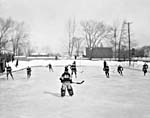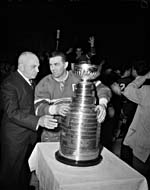          |
|

Although hockey was being played in Montréal in 1875, the players were not French speaking. They were mostly Irish-Catholic students from McGill University.

Playing hockey on the skating rink, McGill University, Montréal, Quebec, 1884
Copyright/Source |
|

Hockey game at McGill University, Montréal, Quebec, 1904
Copyright/Source |
It was not until the 1920s that most of Quebec's hockey players were French-speaking, though French-Canadians began to play around 1895. They were introduced to hockey in college in Montréal. In Quebec, colleges were run by priests. Irish-Catholic students and French-Canadian students went to the same schools, each studying in their own language. In the college yard there was an ice rink and it was there that the Irish students taught the French students how to play hockey.
The schools had their own hockey teams, but most of the players on them were the Irish students. However, the Shamrocks team from Montréal did have three Francophone players: Ernest Pagnuelo in 1897, and Théophile Viau and Louis Hurtubise in 1902.
In 1894, a group of French-Canadian businessmen formed a new hockey club, the Association athlétique d'amateurs nationale (known as the Nationals). This team was meant only for French-language players. For the 1895 season, the club created two hockey teams to play exhibition games. All of the players on the team were students at Mont-Saint-Louis College in Montréal.

Hockey team playing on an indoor rink, Québec City, Quebec, date unknown
Copyright/Source |
|
Early skating rink at Québec City. Prior to 1900, many rinks were not surrounded by boards. Note that the goal does not have a net backing.
|
Canadian senior hockey became professional in 1908. Many good, French-speaking players who had joined professional leagues in the United States came back to play in Montréal. Two such players were Jack Laviolette and Didier Pitre. They joined the Montreal Shamrocks for the 1908 season. They also played an exhibition game with the best Francophone players against the Stanley Cup holders, the Montreal Wanderers.
The game was held on March 10, 1909. The Wanderers won, but only by one goal. The final score was 9-8. As many of the players on the Francophone team were from the Nationals, the game helped the Nationals to return to the senior league, now known as the Canadian Hockey Association.
But a new hockey league was about to be formed by two teams -- the Wanderers and the Renfrew team. The Wanderers were unhappy in the Canadian Hockey Association because of a disagreement over their rink. Most of the teams didn't want to play at the Wanderers' Jubilee rink in the east end of Montréal, preferring the Westmount Arena in the west end of town. The Renfrew team was unhappy because they had tried to join the Canadian Hockey Association but were rejected. So the Wanderers and the Renfrew team decided to form yet another league, called the National Hockey Association. The Association decided they wanted to have a French-Canadian team in their league and a new team called the Montreal Canadiens was born.
On January 5, 1910 the Canadiens were ready to play their first home game when disaster struck. One of their players, Didier Pitre, was reported to have been signed by the Nationals, of the Canadian Hockey Association league. As a result, Pitre was banned from playing for the Canadiens that night. If he did, he risked getting arrested. The battle went to court and in February, the Canadiens won. By that time, they were the only French-Canadian team that remained in the professional league.
The Canadiens won only two games in the first season and the owner, Ambrose O'Brien, had second thoughts about the team. He was thinking of selling the Canadiens when another disaster struck. O'Brien was taken to court by the Club athlétique Canadien for rights to the Canadiens name. They settled out of court and the Club athlétique Canadien and its owner George Kendall-Kennedy were given the team and the franchise. The team was called the Club athlétique Canadien until 1917, when its name changed to Club de hockey Canadien. The team changed owners in 1921.
The Canadiens won their first Stanley Cup in 1916, against the Portland Rosebuds. It was the first time a French-Canadian team had won the Stanley Cup, but not the first time that French players had won it. In 1901, Antoine "Tony" Gingras, of St. Boniface, Manitoba became the first French-Canadian player to ever win the Stanley Cup. His team was the Winnipeg Victorias. Henri Ménard was the second, when he was the goalie for the Montreal Wanderers in 1906.
When we look at French participation in hockey, we look towards Montréal. Hockey's first public game was held in Montréal, and it was the Montréal Carnival that made hockey widely known. The Stanley Cup was also first played in Montréal.

Montreal Canadien hockey team in action against the Toronto Maple Leafs, Montréal, Quebec, circa 1965
Copyright/Source |
|

The Montreal Canadiens enjoy an outdoor practice at home in Montréal, Quebec
Copyright/Source |
But although these hockey moments happened in Montréal, French-Canadian players didn't start playing the sport until about 20 years after hockey's first public game. Despite this slow start it was a French-Canadian team -- the Canadiens -- that gave hockey its most successful team in the history of the sport.
| |

Montreal Canadiens hockey team, October 1942. Back row (left to right): Portland, Lee, Bibault, Laforce, Coupille, Richard, Bouchard. Front row (left to right): Carragher, Harmon, O'Connor, Heffernan, Lach, Demers, Adams
Copyright/Source |
|
Montreal Canadiens pose during pre-season training in October 1942. Promising rookie Maurice Richard (top row, second from right) is about to sign his first professional contract.
|

Stanley Cup trustee Cooper Smeaton presents the trophy to Canadiens' captain Maurice Richard, April 16, 1957
Copyright/Source |
|

Montreal Canadiens' motorcade, April 14, 1956, following Stanley Cup victory
Copyright/Source |
|